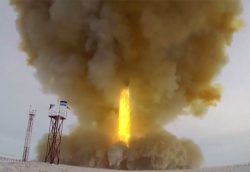 Image courtesy of Ministry of Defense of the Russian Federation
Image courtesy of Ministry of Defense of the Russian Federation
Countering Russia’s Hypersonic Weapons with Arms Control Agreements
A recent Russian weapons testing accident, which resulted in the deaths of 7 and spread radioactive debris, brought the subject of advanced Russian military capability back into the spotlight. The accident is widely believed to be the result of a test of Russia’s Burevenstnik or “Skyfall” missile, a nuclear powered cruise missile Putin has boasted has “unlimited range.” While attention has primarily focused on this incident, Russia also recently showcased its operational hypersonic Kinzhal missile at the Aviadarts 2019 aviation competition. Although these stories reveal some mixed success in Russia’s pursuit of advanced military capabilities, they highlight Russian commitment to modernizing its arsenal through advanced cruise missiles and hypersonics.
The recent display of the Kinzhal may have captured the headlines, but it represents only the tip of the iceberg of the budding Russian hypersonic program. In addition to the Kinzhal missile, Russia is working to add the Zircon cruise missile and the Avangard hypersonic glide vehicle to the ranks of its future hypersonic arsenal. The work on these varied hypersonic projects demonstrates Russia’s determination to bolster its abilities in the hypersonic arena.
Interest in the area of hypersonic weapons, which have been described as a “game-changing technology,” is intense. Countries like the United States, Russia, and China are all in the process of pursuing hypersonic weapons research. Described as “the biggest military challenge of the Trump era,” hypersonic weapons can travel at speeds at or greater than Mach 5. The threat hypersonic weapons pose is not solely due to their speed, but also potentially due to their capability to maneuver in ways that make them difficult to intercept.
This combination of speed and maneuverability means hypersonic weapons present a significant challenge to missile interception systems. In March of 2018, Air Force Gen. John Hyten, commander of U.S. Strategic Command, told the Senate Armed Services Committee, “We don’t have any defense that could deny the employment of such a weapon against us.” This has led Senator Angus King to describe hypersonics as a “nightmare weapon.”
Despite the very real threat posed by hypersonics, some believe that nations like Russia have made advancements in the field without much of an answer from the United States. Although observers have stated “we have lost our technical advantage in hypersonics,” recent years have seen a resurgence in interest among American policymakers as well as support for such programs in congressional budgeting priorities. As the United States steps up its efforts in the hypersonic arena, it enters what has been described as “a new international arms race.”
As nations find themselves in a frenzied competition to develop and defend against hypersonic weapons, it is important to talk about the implications of this emerging technology. For instance, according to RAND, “Hypersonic missiles require a reconsideration of traditional second-strike calculations,” since the missiles could potentially decapitate leadership before it can launch a counterattack. The speed of hypersonic weapons means that for those targeted, there is significantly less time and fewer options available to make defensive or retaliatory decisions. In a situation where nations are potentially subject to sudden and unavoidable crippling strikes, a hypersonic world creates an environment where there is an incentive to fire first. Unfortunately, such an environment would encourage actors to be “trigger happy,” and could very well trigger a war.
Given the dire implications, it is worthwhile to consider what we can do to mitigate such risks. Demonstrating characteristic tact, Putin has recently claimed he offered to sell Trump hypersonic missiles to create parity. Even if such an offer was sincere, the proliferation of hypersonic weapon technology is not the best way to address the potential problems it poses. Although arms control agreements have taken a couple of hard knocks recently, a new arms control agreement aimed at certain classes of hypersonic weapons may be the best means of securing a safer world. We need to work not only with Russia and China, but also our allies to see if we can reach an agreement that allows all parties to be safer.
With the genie nearly out of the bottle, it is unlikely we can reach an agreement that would totally prevent the use of conventional tactical hypersonic weapons. We should, however, attempt to address the strategic threat posed by nuclear hypersonic weapons. A good start would be to work towards an agreement banning the use of hypersonic glide vehicles. In addition to being able to cause significant kinetic damage, some hypersonic glide vehicles are also capable of being armed with conventional or nuclear warheads. Hypersonic glide vehicles, such as the Avangard, are launched using ICBMs and travel in space along a similar trajectory. Should a hypersonic glide vehicle be launched against an adversary, the ambiguity about its payload and its resemblance to traditional nuclear armed ballistic missiles are bound to make targets think they are under nuclear attack, even if they aren’t. We should work with not only Russia and China, but others developing hypersonic glide vehicles to prevent the development and spread of technology that takes us needlessly closer to the brink of nuclear war.





